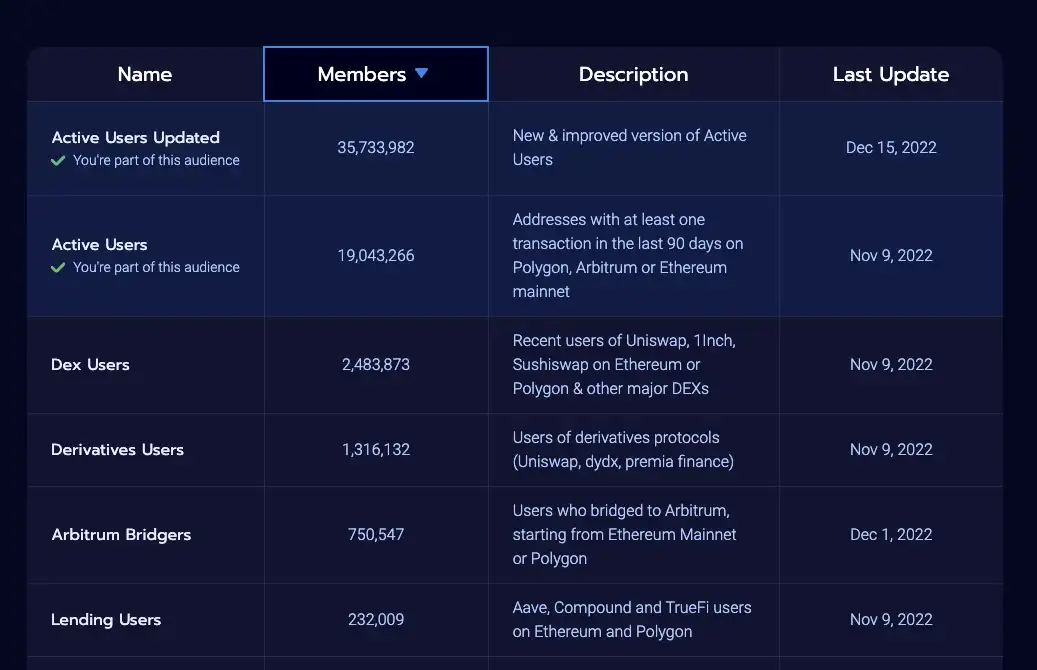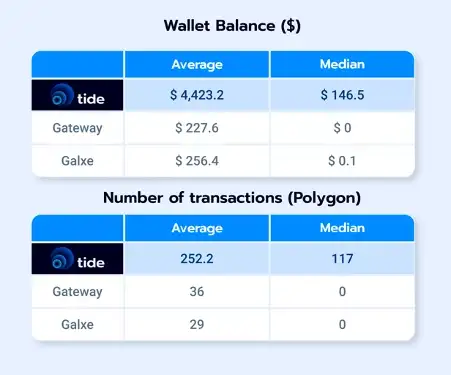Summary
Tide is a web3 marketing protocol that enables any business to issue credentials based on both on-chain and off-chain data. One of the things that sets us apart is our data-driven approach to making campaigns targeted and resistant to Sybil attacks.
In this article, we will explore how Tide works and provide some metrics on the effectiveness of our “Audiences” system.
Targeted quests have a massive impact on the quality of the wallet attracted.
About Tide
Tide mission is to establish a standard for community engagement based on web3 credentials and unique rewards.
We believe that in the next decade web3 will have as much impact on marketing as social media had in the 2010s, and that the marketing managers of the future will use Tide to launch acquisition and retention programs, manage credentials and utilities, and gain insights about their communities through our analytics.
The inorganic activity problem
During our conversations with brands and businesses, we noticed that the most common problem is inorganic activity during the distribution of credentials and airdrops. Anyone can create multiple wallets and repeatedly participate in quests.
The practice of “incentive farming,” or earning cryptocurrency rewards through multi-accounting, originated with the first airdrops in the 2020s and has since proven to be an effective low-risk strategy to make money.
Projects are aware that sybil activity damages web3 growth in the following ways:
-
Makes acquisitions of real users more expensive and less scalable
-
Deteriorates retention
-
Dilutes brand credential value
Tide approach to mitigate sybils
Tide has pioneered a unique approach to Sybil protection by implementing on-chain requirements for campaigns. These requirements allow to identify specific sets of wallets that are relevant for a business or brand. Audiences can serve both as targeting and Sybil protection at the same time.
Some examples:
-
A DEX project may want to distribute credentials and incentives only to wallets with a history of using DEXs.
-
An NFT project may want to distribute WL spots only to wallets with a high holding period.
-
A perpetual DeFi project may want to target only users of options, perpetuals, or derivatives in general.
-
A business may want to reach only active users on a given chain with more than X transactions in the last Y days, or wallets with a credit score greater than XY.
In practice, we have labelled tens of millions of wallets to create gating logic that makes sense. If you are curious about which audience your wallet is in, head over to your profile on Tide and connect your wallet.

Analyze audience effectiveness with an empirical test
To measure the effectiveness of our audiences, we approached it in two ways:
-
Launching campaigns without audience requirements
-
Analysing the wallets of Tide compared to the wallets of other credential platforms with less strict audience requirements.
The multiaccount-friendly campaign
We recently launched a campaign with a Student Association, without audience requirements and with minimal action required. The campaign is still live, and it is gasless and accessible by email, meaning users do not need to hold cryptocurrency in their wallets to participate. We did not perform any marketing activity to promote the campaign, which was meant to target a very specific student audience.
Results: The number of mints skyrocketed — more than 2000 mints in less than 24 hours.
Yet we estimate that 98% of these accounts are bargain hunters looking for free incentives.
Compare this to one of our most successful campaigns — the Second NFTperp trading competition Wave — which got about 2500 mints in 3 weeks with a lot more marketing on Twitter and other platforms created by NFTperp.

Wallet level data
We compared wallet history interacting with Tide to wallets of other credential platforms to understand whether there are significant differences. We analysed the following dimensions:
-
Wallet balance in terms of $USD
-
Wallet number of transactions (on Polygon and Ethereum)

Results: Tide campaign can attract better wallets than other credential platforms, both in terms of balance and number of transactions. Notably, in our sample of more than 100k wallets that interacted with other credential platforms, over 50% of them have $ 0 balance and no transactions, signalling a very strong non-organic activity.
Conclusions:
It is easy to generate sybil data, but the goal of any business is to grow a sustainable, genuine, and thriving community.
Through Tide infrastructure and *audiences *system, anyone can reward only authentic users for performing specific and relevant tasks. This aligns the incentives of all parties involved without solely prioritizing short-term adoption.
Businesses can require users to perform both on-chain and off-chain actions while leveraging wallets footprint for sybil protection and offering selective, flexible rewards for campaign participants.
Visit Tide and start engaging your community.
Check us out at the following links:
TIDE:
